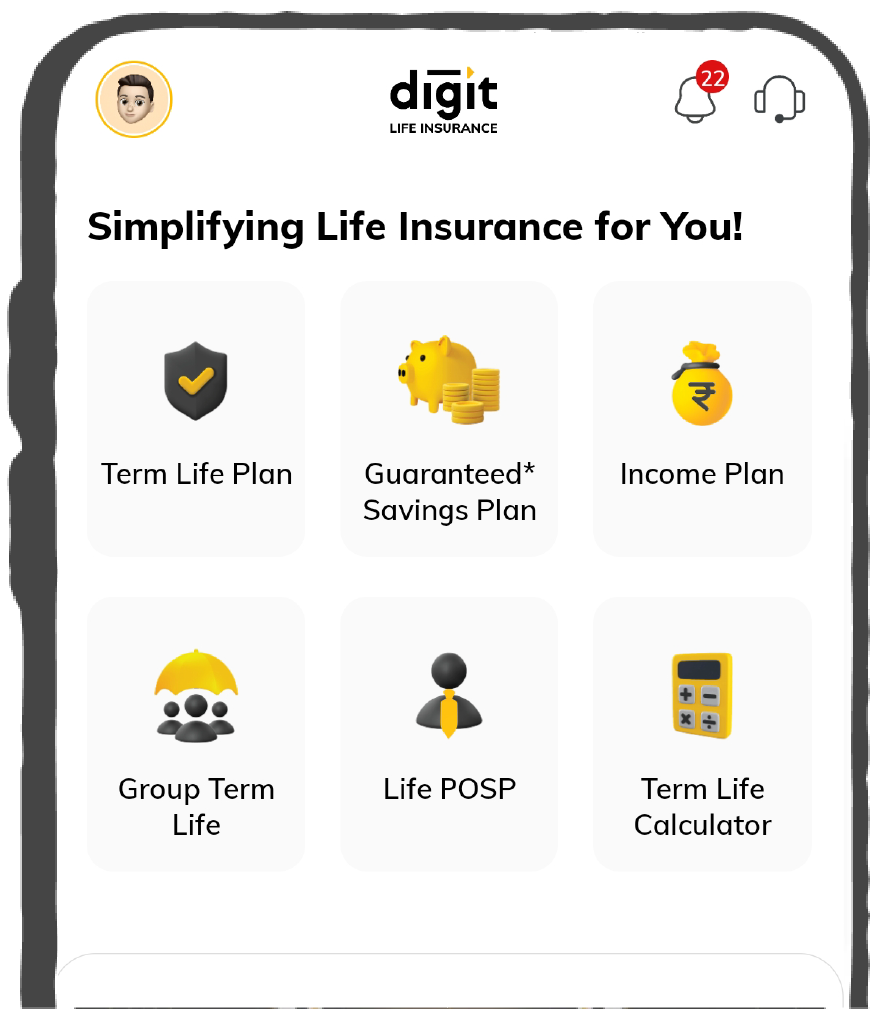What is Renewable Term Insurance Plan and How Does It Work?
While purchasing term insurance, many may worry that the policy will expire before they reach a certain age or that they will lose life cover. A common type of coverage that provides flexibility and protection is constantly renewable term life insurance.
This means that the policy can be renewed when you reach the end of the term, much like renting an apartment with a guaranteed option to renew the lease. In this article, you will learn everything about it in detail.

Table of Contents

What is Renewable Term Insurance?
A renewable term insurance plan is a regular term plan that allows you to renew your existing term plan without having to requalify after the policy's default term expires. Renewable yearly labels are a common feature of term plans.
These plans offer term coverage, which means you can pay the renewal premium annually and continue to receive coverage. When you renew your insurance and policy, you are not obliged to have a medical check-up, nor prove your insurance qualification. These plans offer a renewal guarantee.
How Does Renewable Term Life Insurance Work?
Renewable term life insurance is a type of term life insurance policy that allows you to extend your coverage after the initial term expires without requiring another medical exam. Here's how it works:
Initial Term
When purchasing a renewable term life insurance policy, select a term length, such as 5, 10, or 20 years.
Renewal Option
As the term ends, you can renew the policy for another term. This renewal can typically be done annually or for another set period.
No Medical Exam
One of the key benefits is that you don’t need to take a new medical exam to renew the policy. This can be particularly advantageous if your health has declined since you first took out the policy.
Increasing Premiums
While you can renew the policy without a medical exam, the premiums will increase based on your age at renewal.
Coverage Continuity
The death benefit remains the same throughout the renewals, providing continuous coverage for your beneficiaries.
Age Limits
Some policies may have age limits for renewals, often capping at around 65 to 70 years old.
Understanding Renewable Term Insurance Scenarios with Illustration
Who Should Consider Renewable Term Life Insurance?
Renewable term life insurance can be a great option for individuals depending on their needs and circumstances. Here are some groups who might benefit from considering this type of policy:
Young and Healthy Individuals
Young and healthy people can often secure lower premiums. Renewable term life insurance allows them to extend their coverage without undergoing another medical exam.
People with Changing Life Circumstances
Renewable term life insurance offers the flexibility to adjust your coverage as needed if you anticipate significant life changes, such as starting a family, buying a home, or changing jobs.
Individuals with Health Concerns
If your health has declined since you first took out your policy, renewable term life insurance allows you to renew your coverage without a new medical exam, which can be crucial for maintaining coverage.
Those Needing Temporary Coverage
If you need life insurance for a specific period, such as to cover a mortgage or until your children are financially independent, renewable term life insurance can provide the necessary coverage.
Budget-Conscious Policyholders
Renewable term life insurance can be more affordable than whole life insurance, making it a good option for those looking to manage costs while securing coverage.
People Planning for Future Conversion
If you plan to eventually convert your term policy to a permanent one, having a renewable term policy can give you the flexibility to make that change when it’s most advantageous.
Advantages of Renewable Term Life Insurance
Renewable term life insurance offers several benefits that can make it an attractive option for many people. Here are some of the key advantages:
Guaranteed Renewability
One of the most significant advantages is the guaranteed right to renew your coverage. This means that even if you develop health issues, the insurance company must renew your policy. They cannot deny your renewal, require you to undergo a new medical exam, change your coverage amount, or add any new restrictions to your policy.
Flexibility
You can choose the term length that best fits your requirements and adjust coverage periods as your life circumstances evolve. Additionally, you can cancel or change policies without facing any penalties. If your policy includes the option, you can convert it to permanent life insurance, offering further adaptability and security.
Affordability
It is the most affordable type of life insurance for several reasons, as premiums start lower than permanent insurance, allowing you to pay only for the coverage you need. Since there is no cash value component, the overall costs remain lower. Additionally, the availability of multiple term length options lets you control and manage your costs effectively.
How to Choose a Renewable Term Life Insurance Policy?
1. Consider your Current Financial Obligations
Assess your debts, such as mortgages, children's education expenses, car loans, and credit card balances. Determine how much coverage you need to ensure that your dependents can manage these financial responsibilities in the event of your passing.2. Factor in Major Life Events
Life changes such as marriage, the birth of a child, or a change in job status can impact your insurance needs.3. Review the Full Premium Schedule
Understand how premiums will change over time, especially if you choose a renewable term policy that allows for renewal at the end of each term. This includes knowing the initial premium and how it may increase with each renewal.4. Understand How Rates Increase
With renewable term policies, premiums typically increase as you age. Familiarise yourself with how much the rates will rise at each renewal and make sure it fits within your budget.5. Check the Company's Financial Ratings and Reviews
Research the insurance company's economic stability. Look into customer feedback regarding the insurer's service. Ratings and reviews can provide a clearer picture of how the company treats its customers and handles claims.6. Check for Additional Riders
Riders are add-ons to a policy that provide extra benefits. Common riders include those that allow for a waiver of premium rider, an accidental death benefit rider, or a critical illness rider. Assess if any of these options would be beneficial for your situation.7. Consider Conversion Options
Some term policies allow you to convert to a permanent policy without additional medical underwriting. This feature could be beneficial if your needs change later on.8. Review Exclusions and Limitations
Carefully read the fine print to understand what is and isn’t covered. Knowing the exclusions can prevent surprises later on and ensure you’re adequately protected.When is the Best Time to Buy Renewable Term Insurance?
The best time to buy renewable term life insurance is when you have significant financial responsibilities, such as a mortgage, children to support, or debts. This coverage can provide essential protection for your loved ones in case of an unexpected tragedy.
Additionally, it's wise to consider purchasing a policy when you are younger and healthier, as premiums tend to be lower at that stage of life. This allows you to secure coverage while minimising costs, giving you long-term security for your family.
Renewable Term Life vs Convertible Term Life
A standard renewable term policy can’t be converted to another type of coverage. When choosing a term insurance plan, consider these points to ensure you get the right protection for your needs.
Disadvantages of Renewable Term Life Insurance
While renewable term life insurance has many benefits, there are also some drawbacks to consider:
- With each renewal, premiums rise, often significantly as you age, potentially making the policy unaffordable over time.
- Unlike permanent life insurance, these policies don't build cash value, meaning you can't borrow against them or benefit from any investment component.
- Unlike other life insurance types, if you outlive the policy term, you won't receive a return on the premiums paid.
- There are limits on the age at which you can initially purchase and renew the policy, typically capping initial purchases between 65 and 70 and renewals between 80 and 85.
- These policies offer less flexibility compared to permanent life insurance options, which can be tailored better to meet long-term financial planning needs.
Renewable term insurance offers individuals an affordable way to secure life insurance with the added advantage of renewal options. It allows for proactive financial planning by ensuring that loved ones remain protected throughout significant life stages.
However, policyholders must evaluate their insurance needs regularly and consider premium increases upon renewal, as these could impact long-term affordability. Overall, renewable term insurance can be a smart choice for those seeking a balance between cost-effectiveness and flexibility in their life insurance coverage.
FAQs about Renewable Term Life Insurance
What type of term insurance is renewable?
How does the premium change over time?
What are the benefits of annual renewable term insurance?
Annual renewable term (ART) insurance offers several benefits, including initial affordability and flexibility. It provides short-term coverage that can be renewed each year without a new medical exam, making it suitable for those with temporary insurance needs or those who anticipate changes in their health or financial situation.
ART policies are generally cheaper in the early years compared to other types of life insurance, and they allow policyholders to adjust their coverage annually.
What is the disadvantage of renewable-level term life insurance?
What does a renewable term life insurance policy allow the policy owner?
What is non-renewable term life insurance?
Other Important Articles Related to Term Insurance
Latest News
Read More













